Your guide will have an early start from Windhoek to make the most of this full day that takes you into Etosha and through its most northerly gate. The route from Windhoek passes the town of Okahandja where the first turnoff leads to the woodcarvers’ market. Further north towards Otjiwarongo, the Omatakos, a pair of conical mountains, are prominent landmarks along the route. Termite mounds reach for the sky and warthogs root along the roadside. The B1 passes the towns of Otavi and Tsumeb before you veer left onto the C38 to Etosha’s Von Lindequist Gate. Spend the afternoon enjoying the drive northwards through Etosha. Etosha King Nehale awaits you soon after the King Nehale Gate, where you can kick off shoes and raise glasses as the sun sets over the Andoni Plains, relishing the comfort of this stylish lodge.
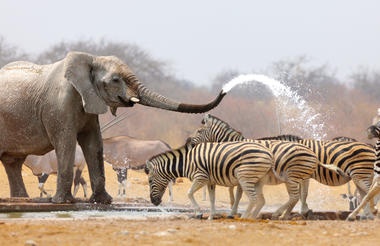
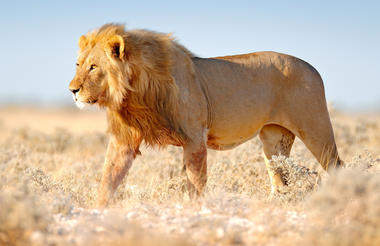
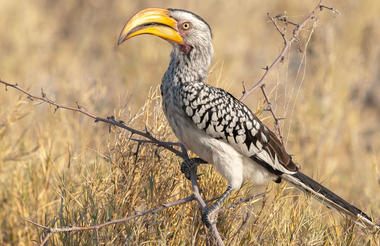
Drive through Etosha National Park
Explore northern and eastern Etosha, visiting the waterholes, which attract a variety of animals that come to quench their thirst. The 22 912km² wildlife haven is home to 114 mammal species, including elephant giants and diminutive Damara dik-diks, and 340 species of birds. Etosha King Nehale has a waterhole reserved especially for lodge guests. Spend the day in the park or return to the lodge for lunch and to relax and luxuriate in your private plunge pool.



AM or PM Etosha National Park Game Drive
The Etosha feast continues as you journey westwards into the heart of the ‘Great White Place’. Etosha has a variety of landscapes and vegetation types including grassland and dwarf-shrub, woodland and thornbush savannah. At its centre is the shimmering mirage-like pan, which fills with water in years of good rainfall and gives the chalky character to the park. The pan formed 120 million years ago when continental drift changed the slope of the land and redirected the course of the ancient rivers, which dried up over time. Day three provides the opportunity to hopscotch from waterhole to waterhole as you travel towards Okaukuejo. Keep in mind that it is often slow-going through the park. Enjoy a lunchbreak midway at Halali. Both the Halali and Okaukuejo camps have popular waterholes, which attract animals large and small. In the late afternoon exit from Okaukuejo at Andersson Gate to drive the ten kilometres to Etosha Safari Lodge. Arrive in time to enjoy a sundowner drink overlooking the mopane woodland, when the world is painted in gold. Enjoy supper at the lodge or reserve a table at Etosha Safari Camp’s Shebeen restaurant for a fun-filled relaxed evening. The restaurant is modelled on ‘shebeens’ (informal township bars) of old, where people gathered to meet, have a drink and listen to music. The colourful and quirky restaurant has become a highlight on travellers’ itineraries. The delicious buffet spread is eaten outdoors as you listen to the Etosha Boys strum their guitars and sing local melodies.
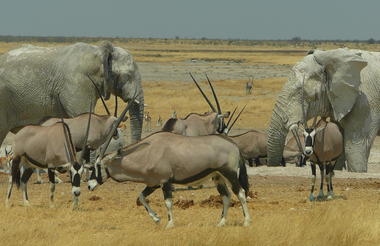
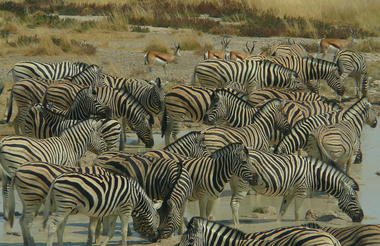
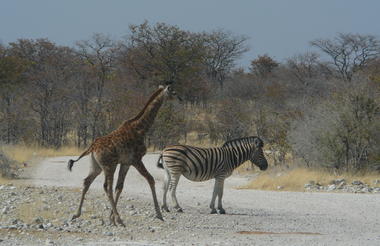
Drive through Etosha National Park
After a leisurely breakfast take the C38 southwards to the town of Outjo, where you’ll be able to fill your fuel tank and stock up with snacks and essentials for the journey. From Outjo take the C40 north-west to Kamanjab. (There is an option to reach Kamanjab on the gravel roads via the D2695, south of Etosha Safari Lodge.) Stock up and fill fuel tanks in Kamanjab before continuing on the scenic Grootberg Pass to Palmwag. Take it slowly and carefully around the bends, and keep eyes open for desert elephants in the valley. Flat-topped Etendeka Mountains and rich red rock dotted with green euphorbias and robust mopane trees characterise the area around Palmwag. Palmwag Lodge is set in a grove of makalani palm trees that mark the underground watercourse of the Uniab River and the lodge overlooks the sweeping Damaraland landscape. Make sure you arrive in time to sip a sundowner as the sun dips in the
GO GREAT – Itinerary
sky, transforming the landscape into deep reds and shades of pastel pink. Arrange your activities for the next day on your arrival before soaking up the beauty of the surroundings.

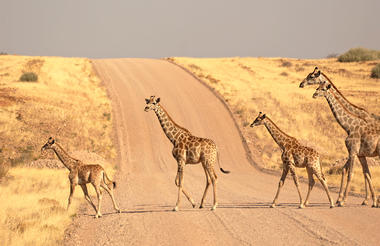
Himba Village Excursion
Choose how best to spend your day at Palmwag. Activities include an early start to track desert-adapted black rhino with the conservancy rhino rangers, taking a guided walk to become better acquainted with the environment and self-driving or joining a sundowner drive into the 582 000-hectare Palmwag Concession, a vast conservation area with an abundance of wildlife. Palmwag collaborates with neighbouring conservancies, the Ministry of Environment and Tourism and Save the Rhino Trust to safeguard this rich wild heritage. During the day, enjoy a relaxed lunch at the pool bar and in the evening keep eyes open for the resident bull elephant ‘Jimbo’, who often makes an appearance.
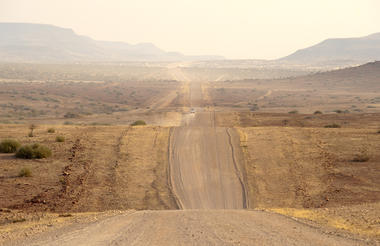
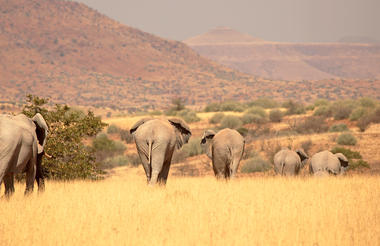

Half Day Rhino tracking
After an early breakfast, travel southwards on the C43 and eastwards on the C39 until the D2612 turnoff to the Twyfelfontein engravings. Two to six thousand years old, the engravings, mostly of animals, were made by hunters and gatherers who congregated at the springs in the mountain in the dry season. It is believed that their shamans chiselled into the Mount Etjo sandstone as a form of prayer as they beseeched the gods for healing, rain, food and protection for their people. Guided walks are available to visit the main sites. If time allows, in the vicinity are also a series of rock formations known as the Organ Pipes and a Damara Living Museum to experience the traditions of the Damara people. The Twyfelfontein Lodge is a convenient place for lunch or a cold drink during the day, or request lunch packs from Palmwag in advance.
Retracing your steps after a fascinating morning at Twyfelfontein, continue on the C39 eastwards towards Khorixas. Another optional stop on the route is the small Petrified Forest where a number of conifers from ancient rivers were deposited millions of years ago, eventually fossilising into stone. Damara Mopane Lodge, a refreshingly different oasis-like lodge, is reached 20km after Khorixas. Built in the traditional design of an African king’s residence, a semi-circular labyrinth of passageways leads to the spacious chalets, each with its own productive food garden. The gardens are planted with a selection of fresh vegetables and herbs, which form part of the delicious supper spread. A gigantic turquoise pool is the perfect place to relax in the afternoon before making your way up to the sundowner deck to toast the day from above the mopane woodland. Stroll back down to the lodge to sit outdoors and enjoy the mouth-watering dinner buffet.
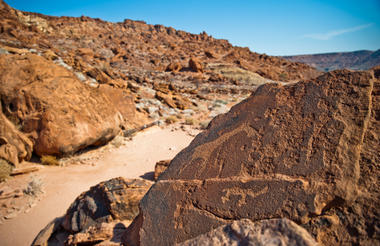
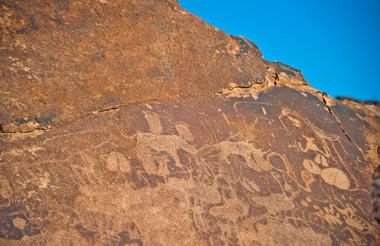
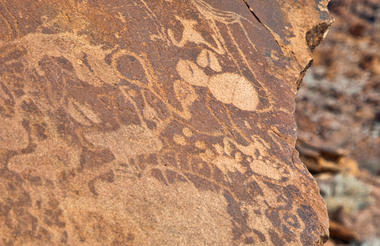
White lady excursion
Burnt Mountain and petrified forest excursion
The coast is calling today, as is The Delight Hotel in Swakopmund. Just before Khorixas take the gravel C35 southwards to Henties Bay. This route takes you past Brandberg, Namibia’s highest mountain, and the town of Uis.
(For those who don’t mind retracing the route from the previous day, an option is to travel along the C39, through the Springbokwasser Gate and down the infamous Skeleton Coast to Swakopmund. The road follows the attractive Huab valley until the coast. Look out for the many welwitschia plants along this stretch of road, and before the Ugab Gate the remains of the South West Seal, a 90-ton South African fishing vessel that caught fire and beached here in 1979. After the Ugab Gate, you’ll notice many fishing spots along this desolate coastline, some with interesting local names like Sarah se Gat, named after a well-known fisherwoman. Visit the colony of Cape fur seals at Cape Cross and enjoy lunch at the adjacent Cape Cross Lodge.)
Elephant caution signs dot the roadside at the beginning of the C35 as the north-western corner is desert elephant territory. The desert elephants often travel along the ephemeral river systems that remain dry until summer rainfall fills their catchment areas. The colourful stalls of the Herero women selling their well-made Herero dolls line the road near the Ugab River. Their striking long dresses, worn even in the stifling heat, and their cow-horn headdresses make a lasting impression. Further along, Himba from further north have also set up their stalls adding to the intrigue. Continuing to Uis, Brandberg (‘Burning Mountain’) appears on the right-hand side. It is so named for its orange-red glow in the late afternoon as the sun catches its granite rock,
setting it aflame in colour. Brandberg’s Königstein peak, at 2573m, towers above the grassy plains. Brandberg is also known for its White Lady rock painting. Much younger than the Twyfelfontein engravings, the Brandberg paintings are estimated to be approximately 2000 years old and are predominantly of people. The name ‘White Lady’, coined by Henri Breuil in 1955, is now understood to represent a healer or medicine man holding a bow and arrow in one hand and a cup or wand in the other. The guided walk to see the painting is a two- to three-hour return trip, only to be included if time allows. Ensure that you carry enough water and wear closed shoes and a hat. Uis is a convenient place for a lunch or tea stop and to fill fuel tanks. Cactus and Coffee on the outskirts of the town serves light meals and coffee and cake in their outside courtyard. It’s still 100km on the gravel to reach the coast, so don’t linger too long. Around Uis, roadside stalls, often creatively decorated, sell an array of colourful Namibian gemstones.
South of Henties Bay, you’ll find the 2008 Zeila wreck, a fishing trawler whose towline broke in the early hours. It is only 70km from Henties to Swakopmund on the tar and the excitement starts to escalate as you enter this unusual town, with its early-20th century German architecture, fringed by the icy Atlantic on the one side and the Namib Desert on the other. Swakopmund is often shrouded in a curtain of mist, the precious moisture that sustains the flora and fauna of the Namib. So, don a jersey and make your way to your bright and cheerful home for the next two nights. Welcome to The Delight!
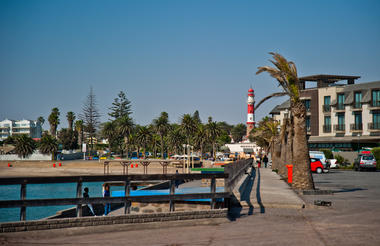


The Delight has one of the best breakfasts on offer, featuring Walvis Bay oysters and champagne. Savour the breakfast spread before venturing into town. Swakopmund is known as the activity centre of Namibia and a choice of activities is available from kayaking in the Walvis Bay lagoon, dolphin cruises and living desert tours to sandboarding and skydiving. Ensure that you make your bookings on arrival and also the necessary dinner reservations. If you still feel in the mood for a drive, the stretch to Walvis Bay is a spectacular route between the dunes and the sea, and the small Walvis Bay waterfront is a relaxed spot for lunch. The road along the lagoon and to the salt works is often a good route to view flamingos. If you prefer to stay home, Swakopmund is the ideal place to leave the vehicle parked at the hotel and explore on foot. Visit the museum, have a bite to eat at one of the many cafes and restaurants, and at the end of the day take a walk along the jetty to watch the sun sink into the sea.
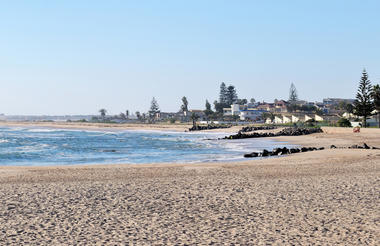
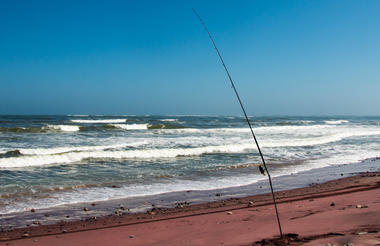
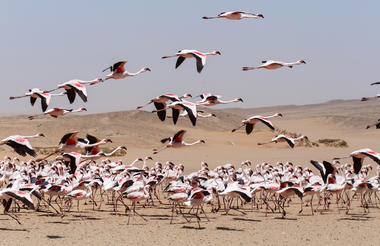
You have another opportunity to enjoy The Delight’s breakfast before you return to the capital city. The drive is approximately four hours. Make a stop along the way at the Ûiba-Ôas crystal market at the turnoff to Spitzkoppe for one of the finest displays of Namibian gemstones. Further on, the Wilhelmstal Padstal is a good place for Apfelstreusel and biltong. After that it’s only a hop and a skip back to Windhoek as you breeze along, reminiscing about the incredible adventures of the trip.
Your guide will drop you at your Windhoek accommodation for the night.


